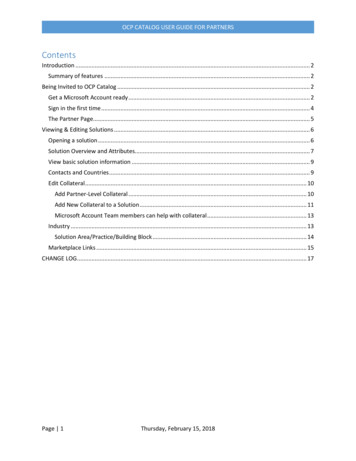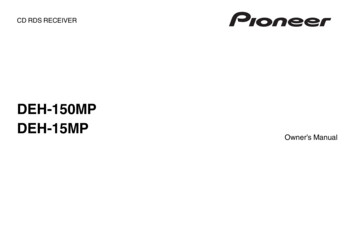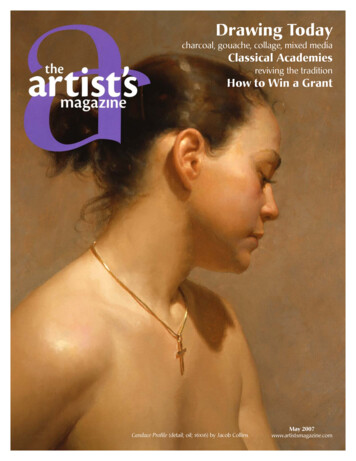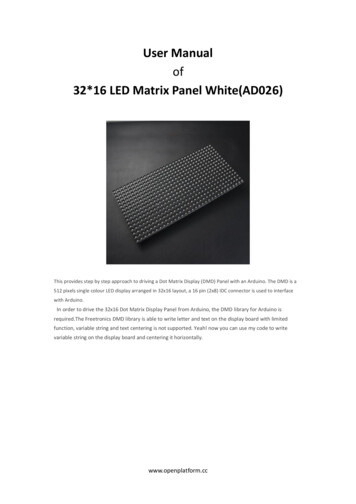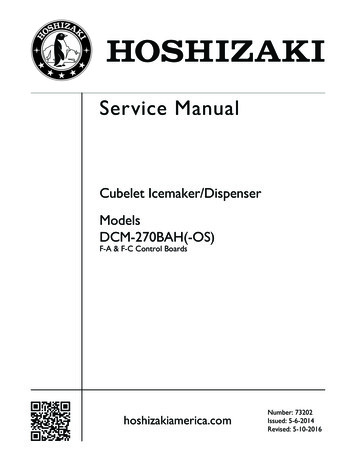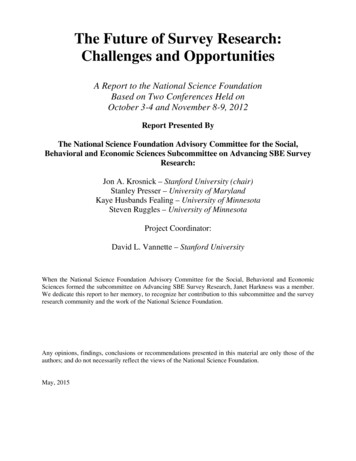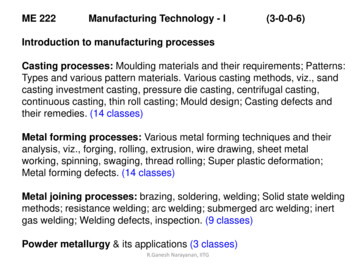
Transcription
PAR T T WOPosters
La Virgen del Perdónafter the Fire of 1967Elsa M. Arroyo LemusIn 1569, two years after his arrival to New Spain,the Flemish painter Simon Pereyns was accusedof heresy, imprisoned, and tortured by theInquisition. The artist was condemned to createan altarpiece for the Cathedral of Mexico. TheVirgen del Perdón would be the central piece ofthat altar (fig. 1). This painting may well be theearliest extant work of Pereyns.On January 17, 1967, the altarpiece burneddown in a fire caused by a short circuit. TheVirgen del Perdón lost 80 percent of the paintedsurface, and the wooden panel was convertedinto charcoal (fig. 2). Since this disaster, thepainting has been considered a “premature ruin”because of its sudden transformation by fire.The aim of this research was to learn aboutthe cultural biography, painting technique,and current deterioration of Pereyns’s paintingthrough historical investigation, technical studyof the panel painting, and reconstruction of thepainting to reproduce the alteration process.Samples prepared according to the original painting technique were tested under a temperaturedistribution ranging from 100ºC to 190ºC, inorder to investigate the materials’ physical andchemical changes. The heated samples were analyzed by optical microscopy, scanning electronmicroscopy with energy dispersive X-ray analysis(SEM-EDX), and X-ray diffraction (XRD).We determined the process of alteration:the inception of the wood’s chemical decomposition; the boiling point of the resin present inpinewood; the morphological, topological, andcrystalline phase transitions of the gesso layerscaused by the heat increase; and the shrinkageof fibers made from animal tendons used in thepreparation of the panel. This research generated specific deterioration effects: contraction ofthe gesso layer; separation between preparation,priming, and color layers; bubbles in the interiorof the paint coats; darkening of glazes; and a blistering texture on the surface.AcknowledgmentsFig ure 1Simon Pereyns (Flemish, ca. 1540–1589, active in Mexico),La Virgen del Perdón, 1569. Oil on panel, 274 220 cm (107.9 86.6 in.). Archivo Fotográfico Manuel Toussaint, Instituto deInvestigaciones Estéticas, Universidad Nacional Autónomade México, Mexico City. Photo: Felix Leonelli.This research has been supported by thePAPIIT (Programa de Apoyo a Proyectosde Investigación e Innovación Tecnológica)IN402007 project, developed in collaborationwith Alfonso Torre Blanco, Tatiana Falcón,Eumelia Hernández, Alejandra Quintanar,Manuel Espinosa, Jose Luis Ruvalcaba, VictorSantos, and Sandra Zetina.193
194Poster sFig ure 2Detail of Simon Pereyns, La Virgen del Perdón, showing a fragmentof the Virgin’s face damaged by the fire. Photo: EumeliaHernández.
Poster s195Search for a DimensionNeutral Effect in the SolventTreatment of WoodWendy Baker and David GrattanBulk consolidation of badly deteriorated woodcontinues to be a treatment option, especiallyif the object is subject to handling or exhibition or if it is functional, such as a frame (fig. 1).Wood consolidation tests reveal that solventscan provoke dimensional changes in wood, andany movement of the wood will have obviousimpacts on the stability of design layers and onthe structural integrity of the treated object.Attempts to predict the behavior of woodto a range of solvents based on certain variables(solvent polarity, molar volume, dielectric constant, hydrogen bonding parameters, etc.) provedto be unsatisfactory as a guide to the behavior ofwood to specific solvents. Systematic testing isnow under way to characterize the behavior ofselect species of wood to solvent action. To date,we have documented the radial swelling and/orshrinkage of two species—white oak (fig. 2) andeastern white pine—to various organic solvents:anhydrous alcohol, propan-2-ol, n-butanol, toluene, pentane, and solvent blends (toluene-ethanol1-1, 2-1, 4-1, and 6-1).Preliminary results show characteristiceffects by specific solvents in the two test species.Differences between the species occur only inFig ure 1Wood severely damaged by insects, for which bulk consolidationcould be considered a treatment option. Photo: Reproduced withthe per mission of the Canadian Conservation Institute ofthe Department of Canadian Heritage. All rights reserved.
196Poster srate and in degree of response: oak has a slowerrate as well as a greater degree of responsethan pine. Anhydrous alcohol causes significantswelling of wood, with maximum swelling of2.75% for oak and 0.6% for pine. Propan-2-ol andn-Butanol provoke an initial shrinkage (0.25%for oak and 0.2% for pine), followed by a gradualswelling that reaches a maximum of 1% for oakand 0.4% for pine. Both toluene and pentane pro-voke shrinkage: 0.25% for oak and 0.2% for pine.The solvent blends, formulated to mitigate theeffect of one solvent by another, exhibited non ideal behavior.Further testing is planned for other woodspecies. The effects of consolidants on swelling and shrinking characteristics will then beexamined.3.0Change in dimension 00Time (h)Anhydrous alcoholPentanePropan-2-olFig ure 2Change in dimension of white oak samples exposed to pure solBakerFig2.aivents. Graph: Reproduced with permission of the CanadianConservation Institute of the Department of Canadian Heritage. All rights reserved.Toluenen-butanol16001800
Poster sStabilization and Rejoining of a SeventeenthCentury Panel Painting: Portrait of PhilipMelanchthon, Parish Church of Prießnitz/SaxonySabine BendfeldtThis wooden panel measuring 186 86 cm(73.2 33.9 in.), with an original thicknessof only 1 cm (0.4 in.), had separated along allthe joins. The six boards were originally stabilized by two cross battens on the reverse.Furthermore, the panel was broken across thetrack of the lower cross batten, which was badlydamaged by woodworm (fig. 1).Before stabilization, the damaged woodwas consolidated with an acrylic resin, PlexigumP28, and the lost parts were replaced with smallinserts of limewood. The repair of the crossbreak, where only half of the panel thickness,just 0.5 cm (0.2 in.), remained, was particularly difficult. It was necessary to fill the trackwith small inserts of limewood to enlarge thesurface. In addition to a reconstruction of thepanel thickness, long grooves measuring 0.5 0.5 cm (0.2 0.2 in.) with a length of about50 cm (19.7 in.) were made on the reverse alongthe grain, and they were filled with inserts oflimewood to overlap the break over a wide area.Once this preparatory work was completed, thebroken board pieces were joined together.In order to provide additional support, akind of in-frame tray was made. It consisted ofa low-emission medium-density fiberboard onwhich the painting rests. It is held in place withwooden strips that run along the edges of thepainting and which form the frame.With this new method, it was possible torejoin the individual parts of the panel withoutusing an auxiliary support (fig. 2). The limewoodinserts placed in the long grooves across thebreak strengthen it against bending and preservethe original surface of the reverse of the paneland its natural movement.Fig ure 1Portrait of Philip Melanchthon, Parish Church of Prießnitz/Saxony,17th century. Oil on panel, 186 86 cm (73.2 33.9 in.). ParishChurch of Prießnitz/Saxony. Prior to treatment, all joins wereseparated, and in the lower part, the boards were broken acrossthe panel. Photo: Sabine Bendfeldt.197
198Poster sAcknowledgmentsThis work was carried out as a diploma projectat the Academy of Fine Arts in Dresden underthe supervision of Prof. Ulrich Schießl, Prof. IvoMohrmann, and Ms. Christine Kelm.Fig ure 2The reverse, after treatment, of Portrait of Philip Melanchthon,Parish Church of Prießnitz/Saxony. The wooden inserts are lighterin color. Photo: Sabine Bendfeldt.
Poster s199The Structural Stability of the Plywood PanelSupport of Salvador Dalí’s Couple with Clouds inTheir Heads and Their Bespoke Frames from 1936Gwendolyn P. Boevé-JonesThe ongoing treatment of Salvador Dalí’s Couplewith Clouds in Their Heads, his two-part selfportrait with Gala from 1936, presents an opportunity to look at multiplex panels as an artist’ssupport in relation to their conservation andrestoration (fig. 1). While numerous artists usedmultiplex in the 1930s, including Picasso andMagritte, Dalí used the cutout forms in a novelway. This artwork has never been treated beforeand has been glazed since 1936. The originalglass was replaced in 1998 with a much thicker,heavier museum conservation glass.In general, the stability of the multiplexpanel is very good, although there is slight warpFig ure 1Salvador Dalí (Spanish, 1904–1989), Couple with Cloudsin Their Heads [Couple aux Têtes Pleines de Nuages], 1936.Oil on panel, 92.5 96.5 5 cm (36.4 38.0 2.0in.). Museum Boijmans van Beuningen, Rotterdam,2988 (MK). Reverse of male figure and frame, showingthe somewhat incoherent relationship between the outline of the panel and the frame. Photo: Margo Vintges,Redivivus.ing of both panels. More importantly, there isparticular concern about the uppermost thinveneer, on which the ground and paint layersare applied. Vertical fissures that seem to correspond to the grain of the veneer have formedin areas in both the ground and the paint layers.Some of these areas were previously damagedby an unusual degradation of the varnish andpaint layers, and at these points, the fissuresare more pronounced and alarming. First, the five-ply 9 mm (0.4 in.) multiplex was identifiedas Okoumé mahogany (fig. 2). It is surmised thatthe “tenderizing” of the veneer during the manufacturing process contributed to the eventual
200Poster sStructural Interventions onSixteenth-Century MonumentalOak Panels in Tomar, PortugalMiguel Garciadevelopment of the fissures. It is very possiblethat an animal glue size applied by the artist ontop of the veneer was also a contributing factor.The frames are an integral part of thework of art. The bent and formed wood shapesare complicated objects in and of themselves.Furthermore, the silhouette frames do notmatch the shape of the panels very precisely, nordoes the modern glass fit the frame properly.Replacing the museum conservation glass with3 mm (0.1 in.) acrylic museum glazing shouldhelp with both the weight-bearing issue andwith achieving a more perfect fit with the frame,without significantly altering the appearance ofthe work of art.In March 1160, in Tomar, Portugal, a roundchapel was inaugurated along with a TemplarKnight castle. Over three centuries later, in 1515,through an extraordinary artistic campaign, thechapel was decorated by Portuguese masterswho were clearly influenced by Flemish art(fig. 1). Here, an elite corporation of artistspainted twelve monumental Baltic oak panels:Baptism of Christ, The Synagogue, The Resurrectionof Lazarus, Christ Entering Jerusalem, The Surrenderof Christ, The Resurrection, Descent into Hell, TheAscension, Our Lady of the Sorrows, The Pentecost,The Last Judgment, and The Holy Trinity.Fig ure 2Detail of Salvador Dalí, Couple with Clouds in Their Heads, showing the five-ply mahogany panel. Photo: Margo Vintges,Redivivus.Fig ure 1The interior of the round chapel in Tomar, Portugal. The nichesfor the panel paintings are located in the middle section. Photo:Miguel Garcia.
Poster sThe recent investigation and conservation took place over a four-year programfirst organized by the Instituto Portuguêsda Conservação e Restauro (IPCR) and laterby the Instituto Português do PatrimónioArquitectónico (IPPAR).Each panel, measuring around 4 m highby 2.40 m wide (157.5 94.5 in.), is composedof ten boards that are 4 cm (1.6 in.) thick withvertical grain. Dendrochronological analyses carried out by Peter Klein assigned a possible date of manufacture of between 1488 and1499. Observations of the support revealed earlyadaptation of cross battens and identified biodegradation in some places, which has been causedby a combination of fungus, termites, and woodbeetles. The damage is more extensive on theouter boards.On a few of Lazarus’s original boards,volumetric reconstructions were madewith slim trapezoidal Castanea sp. inserts,put together in several layers with PVA asthe adhesive. The same adhesive was used tofix the open joints of the whole boards. On boththe Lazarus and the Christ Entering Jerusalempanels, the cross battens were replaced withaluminum bars that slide over small bridgesections of wooden blocks held in place withslim flat brackets of the same metal (fig. 2).This not only creates a light structure but alsoreinforces the panel.The larger fragment from The Synagoguewas treated in the same way wherever needed,and a small fragment placed incorrectly in a previous restoration campaign is now positionedproperly.Fig ure 2The aluminum backreinforcement. Photo:Frederico Henriques.201
202Poster sStructural Treatment ofa Seventeenth-CenturyFlemish Panel PaintingJames Hamm, Sandra Kelberlau, Dawn Rogala,Aniko Bezur, and Jonathan ThorntonA donated seventeenth-century Flemish panelpainting, The Mystic Marriage of Saint Catherine,provided an opportunity for Buffalo StateCollege Art Conservation Department facultyand students to perform analysis and investigative treatment. The painting consisted of five oakplanks joined vertically, with overall dimensionsof 121.9 91.4 cm (48.0 36.0 in.), thinned andcradled sometime in the nineteenth century, followed by several restoration campaigns that allinvolved regluing, filling, and overpainting.Treatment of the painting included theremoval of the nineteenth-century cradle andthe design and attachment of a cradle systeminspired by designs developed by Bobak andMarchant. The new cradle consisted of a doublespine fixed to a lightweight perimeter framework; ten tapered, flexible basswood ribs joinedto the spine; numerous pairs of small oak blocksglued to the panel reverse to minimize thedirect-attachment footprint (fig. 1); and four vertical, sliding, removable battens that attach thecradle structure to the panel. The design allowsthe thin wooden panel to expand and contractFig ure 1Fitting the new cradle onto the panel. The oak block pairs areready to receive the vertical sliding battens that lock the horizontal battens against the panel. Photo: Art ConservationDepartment, Buffalo State College.
Poster swithin a limited range of motion as environmental conditions fluctuate (fig. 2). The added forcesof the new auxiliary support that the panel issubjected to are minimal compared to those ofthe previous cradle design, since the entire structure is supported by the perimeter framework,rather than by the panel itself.Questions regarding the use of such a cradle design remain: What is the overall dimensional limit for thistype of cradle system? How should the number, thickness, width,and flexibility of the ribs be more accuratelydetermined? What are the optimal dimensions and spacingof the central double-spine elements? What range of movement should be allowed,and when should restrictions be imposed?Fig ure 2The new cradle attached to the panel, which is now ready forframing. The weight of the panel rests on the bottom perimetersupport bar. Photo: Art Conservation Department, BuffaloState College.203
204Poster sStructural Consolidation andStabilization of Panel Paintings atthe Academy of Fine Arts, KrakówGrzegorz Kostecki and Aleksandra HolaThe tradition of the Department of Conservationand Restoration of Panel Paintings, part of theFaculty of Conservation and Restoration ofWorks of Art at the Academy of Fine Arts inKraków, dates to 1950. Since the 1970s, acrylicresins—like Paraloid B-72, Osolan K (copolymerof butyl methacrylate and methyl methacrylate),and Osolan KL (polybutyl methacrylate)—havebeen used for impregnation; however, consolidation of wood has not been done frequently.Natural adhesives (sturgeon glue and rabbit-skinglue) are usually used for rejoining splits andgaps, as well as for strengthening and reintegration. Butt joints are strengthened with 8-shapedwood pieces and stabilized in a vertical position with D-shaped wooden cleats. Losses areFig ure 1Auxiliary support system adapted to thewarp of the painting: 4 mm (0.2 in.) thinmovable ash crossbars and walnut pegsattached to the panel. Photo: GrzegorzKostecki. Copyright by Grzegorz Kostecki,Wawel Royal Castle, Jagiellonian UniversityMuseum, Kraków, Poland.filled with pieces of wood, epoxy modelingpaste (e.g., Axson SC 258, Araldit SV 427), orwood-flour filler.Linear stabilization of a panel is regardedas one of the most difficult operations. The principles of Let the panel move and Do not forcibly correct deflection of a panel are foundational for theformulation of guidelines for all interventions:Allow wood movements ample room while, atthe same time, exerting a certain amount ofrestraint to keep the panel from deforming.In our interventions, the original crossbar housing is usually reused. If it is missing, asimple peg system attached to the panel can bearranged (fig. 1). The movable crossbar system,developed in Florence, Italy, is held in place by
Poster s205pegs that are glued to the panel with an epoxyadhesive. To ensure perfect glide, paraffin isapplied onto the crossbars and pegs. Sometimesthese typical auxiliary support systems cannotbe adapted for certain paintings. In such cases,an indirect system is required, which is joined tothe picture frame (fig. 2).Fig ure 2Simple indirect support system consistingof several elastic brass plates with springs,screwed to the frame along the panel edges.Photo: Grzegorz Kostecki. Copyright byGrzegorz Kostecki, Wawel Royal Castle,Jagiellonian University Museum, KrakówPoland.
206Poster sAlleviating Stress in theFraming of Panel PaintingsRay Marchant and Devi OrmondDimensionally responsive panels can suffer serious damage through poor or unsympatheticframing, such as the use of restrictive perimeter retaining clips, which can induce stress.Monitoring the dimensional response of a panelin relation to changes in relative humidity (RH)is essential when a framing method is chosen.The unattached framing support illustrated here is easy to design and construct tosuit a variety of formats, ranging from small,fragile panels to large, heavy ones (fig. 1). Thesupport will allow for large dimensional changesto take place in the surface contour, throughbatten f lexibility and careful placement of thecontact points. When combined, a number ofFig ure 1Large, heavy, and responsive seventeenth-century Flemish panel.The panel is secured in its frame with the flexible batten systemand bearings. Photo: Ray Marchant.points of low resistance can securely hold apanel in its frame but allow it to alter its curvature, and the panel will be encouraged to returnto the set profile when conditions recover. Therigid central bar, to which the f lexible battensare attached, is recessed into the reverse of theframe (fig. 2).Larger heavy panels can also be very sensitive to changes in RH, and movement can oftenbe inhibited by their own weight. The restrictedmovement of the bottom edge of the panelwithin the frame rebate can result in structuraldamage. The use of bearing supports is generallyonly necessary on large heavy panels with horizontally aligned boards.
Poster s207Marvel Seal Envelopes at theMetropolitan Museum of ArtM. Alan MillerMicroclimate packages are often used to isolatepanel paintings from fluctuating environmentalconditions. The Metropolitan Museum of Art inNew York uses a system referred to as a MarvelSeal envelope, which has evolved since it wasfirst developed in the early 1990s. Because of thevolume of paintings lent by the Metropolitaneach year, it is important that we use a systemthat is both effective and practical. The MarvelSeal envelope, a self-contained package madefrom easily obtained and inexpensive materials, can be easily inserted and removed from aframe. It can be assembled quickly, modified simply to accommodate most paintings, and readilyopened and resealed. Instructions for assemblinga Marvel Seal envelope are given in figures 1a–f.If the envelope is assembled properly, it containsa minimal amount of air and has an extremelylow rate of leakage.Fig ure 2View showing the ends of the flexible battens. The balsa andPlastazote foam-sandwich pads exert slight pressure on the joinsof the boards. Photo: Ray Marchant.
208Poster sF i g u r e 1aStep a. Cut a perimeter strip of Marvel Seal long enough to wraparound the glazing. Apply a continuous piece of clear packing tapealong one edge of this strip, leaving about 7 mm (0.3 in.) hangingoff the edge (this measurement corresponds to the thickness of theglazing, plus extra to adhere to the front). Photo: M. Alan Miller.F i g u r e 1bStep b. Apply packing tape strips to each side of the glazing. Foldeach packing tape strip back onto the glazing and temporarilyhold it with tape. Photo: M. Alan Miller.F i g u r e 1cStep c. Attach the perimeter strip to the edge of the glazing and wrapit around. The packing tape should extend past the edge of the glazing. Apply a piece of packing tape to the overlapping join. Fold theoverhanging tape onto the front of the glazing. Photo: M. Alan Miller.F i g u r e 1dStep d. Carefully bring up each packing tape strip (now on theinside) and adhere it to the inside of the perimeter strip. Photo:M. Alan Miller.F i g u r e 1eStep e. Place the Marvel Seal envelope into the frame and addspacers with double-stick tape. Place the painting and the MarvelSeal back sheet into the package. Fold and tape down the sides.Photo: M. Alan Miller.F i g u r e 1fStep f. Remove the Marvel Seal envelope package from the frameand carefully tape-seal all joins. This package can now be securedinto the frame. Photo: M. Alan Miller.
Poster s209The Conservation of an Insieme:The Madonna of Aracoeli and ItsHistoric DisplayCostanza Mora, Beatrice Provinciali, Albertina Soavi,Roberto Saccuman, Elisabetta Giani, and Angelo RubinoThis eleventh-century icon from Rome’s Basilicaof Aracoeli, made of tempera and punched goldleaf on panel, has a double engaged frame. Itwas housed in a chestnut frame case that wasgilded and decorated with punchwork. Both theicon and its frame case were placed in a woodenbox lined with an eighteenth-century decoratedpaper (fig. 1). The painting surface, covered withyellowed varnish and inpainting, had large lossesof color near the frame. The wooden support,seriously damaged from insects, had deep crackscaused by a flat heavy cradle applied during aprevious restoration, which restricted the naturalmovements of the panel.Fig ure 1Madonna of Aracoeli, third quarter of 11th century. Tempera andpunched gold leaf on panel (Fagus), 82 51.5 2 cm (32.3 20.3 0.8 in.). Basilica of Aracoeli, Rome. The icon, its framecase, and its external box are shown. Photos: Istituto Superioreper la Conservazione ed il Restauro.The new oak cradle, composed of threepairs of members across the grain and two lateral members, forms a single controlling frame(fig. 2). Each of the pairs of horizontal membershas grooves that house five movable aluminumblocks connected by a pair of sliding stainlesssteel pins. The connection to the back of thepanel is made by a brass screw nut, which passesthrough the block and tightens the screw into aring. A helical steel spring, tightened and pressured by the brass screw, checks the wood’smovements.The paint layer was cleaned to removevarnish and overpainting. The most unsightly
210Poster slacunae were retouched with reversible watercolors in the tratteggio technique developed atthe Istituto Superiore per la Conservazione ed ilRestauro in Rome.To evaluate the possibility of preserving the old conservation and exhibition system(frame case and wooden box), a microclimatewas temporarily created on the church’s altarand inside the niche by the installation of polycarbonate glazing. The results of monitoringsuggested the need to improve the old conservation system. The box was restored by coveringthe external sides with stainless steel panelscoated with cork. The front was closed withlaminated glass sealed with neoprene strips, toreduce air and dust ingress.Fig ure 2The new cradle for the Madonna of Aracoeli. The inset detailshows the mobile components. Photos: Istituto Superiore per laConservazione ed il Restauro.
Poster s211Finding Solutions forMounting Ancient EgyptianFunerary PortraitsNicola Newman and Lynne HarrisonThe Department of Ancient Egypt and Sudanat the British Museum holds a collection ofthirty Roman-period (30 bc–ad 395) funeraryportraits painted on wood panels. The portraitswere painted from life, and after death, eachwas attached over the face area of the mummified and wrapped body. To ensure the continuedpreservation and accessibility of the portraits,the British Museum Department of Conservationand Scientific Research has initiated a researchproject, the aims of which are to further understanding of the mechanisms of deterioration displayed by many of the portraits, and to developan informed and cohesive approach to theirtreatment and mounting.The two portraits presented here are considered to be in the greatest need of conser vation: Portrait of a Woman (fig. 1) and Portraitof a Man (fig. 2). Both portraits were acquired bya Viennese dealer, Theodor Graf, in the 1880sand were said to come from excavations ater-Rubayat in the Faiyum region of Egypt. Eachis mounted on a wood cradle and has a releaselayer of a paper-like material between the cradleand the portrait panel. In both cases, the releaselayer is failing, leading to splitting and cuppingof the panels, which in turn is causing flaking ofthe paint surfaces. Ongoing research is establishing the extent of previous intervention and theunderlying causes of deterioration.AcknowledgmentsThe authors would like to acknowledge CarolineR. Cartwright, Andrew Middleton, GiovanniVerri, Antony Simpson, John Taylor, andKevin Lovelock, their colleagues at the BritishMuseum.Fig ure 1Portrait of a Woman, Roman-period Egypt, AD 160–170. Encausticon limewood panel, 443 203 1.5 mm (17.4 8.0 0.06 in.).British Museum, London, EA 65346. Photo: Trustees of theBritish Museum.
212Poster sThe History of Cradling inthe Frans Hals Museum,HaarlemJessica RoedersFig ure 2Portrait of a Man, Roman-period Egypt, ad 150–180. Temperaon limewood panel, 420 220 1 mm (16.5 8.7 0.04 in.).British Museum, London, EA 74832. Photo: Trustees ofthe British Museum.Cradling was a common procedure that continued through the late 1950s at the Frans HalsMuseum. This technique has led to structuralproblems that current conservators now encounter. Treating cradled paintings can be difficultand often requires the help of a specialist, asmost conservators are not sufficiently trained inhandling these complex problems.Eleven cradles out of thirty-five panelpaintings researched could be connected to fourconservators. Some are marked on the reversewith the name of the conservator. Others wereidentified from descriptions in archival recordsor from information gathered from interviews.The studio of the De Wild family (Carel,Derix, and Martin) in The Hague was often hiredbetween 1900 and 1928 by the museum. This studio sometimes marked its cradled panels (fig. 1).A private conservator, van Bommel, providedcradles between 1922 and 1930; he signed anddated those cradles in pencil (fig. 2). The restorerJ. A. Tenderloo, who worked in the Frans HalsMuseum from 1936 to 1952, prepared cradleshimself. From 1952, the conservator Han Boltebrought the panel paintings to a woodworker tobe cradled.The treatment of a panel painting, cradledin the 1950s by Tenderloo, was carried out underthe guidance of Jean-Albert Glatigny. The problematic cradle was removed, and a new, moreappropriate auxiliary support was applied.AcknowledgmentsThe author would like to acknowledge all thepersons who helped with this research, withspecial thanks to Liesbeth Abraham, Al Brewer,Jos Deuss, Joris Dik, Menno Dooijes, Esther vanDuijn, Michiel Franken, Jean-Albert Glatigny,Ger van Greven, Ray Marchant, Mireille te
Poster sMarvelde, Devi Ormond, Carol Pottasch, KateSeymour, Hans Susijn, Johanneke Verhave, IgeVerslype, Bill Wei, Wil Werkhoven, AnnekeWouters, and Warda Zetteler.Fig ure 1Detail of the reverse of a panel paintingbranded “DE WILD.” Dirck Francoisz Hals(Dutch, 1591–1656), Garden Party, ca. 1620.Oil on wood, 38 55 cm (15.0 21.7 in.).Frans Hals Museum, Haarlem, OS 75 304.Photo: Frans Hals Museum.Fig ure 2Detail of the reverse of Pieter Saenredam(Dutch, 1597–1665), Interior of the Pieterskerk,Utrecht, 1654. A note in pencil reads,“Geparqueteerd in 1930 B. van BommelAmsterdam.” Oil on wood, 50 72.5 cm(19.7 28.5 in.). Frans Hals Museum,Haarlem, OS 75 339. Photo: Frans HalsMuseum.213
214Poster sTechnical and ConservationStudy of the Wooden Support ofThe Pentecost by Vasco FernandesJoana Salgueiro and Salomé de CarvalhoThis study is the result of a partial combinationof two PhD treatises on painting conservation,“The Sixteenth-Century Portuguese Painting ofVasco Fernandes: Technical and ConservationStudy of the Wooden Supports” by JoanaSalgueiro, and “History, Theory, and Deontologyof Conservation and Restoration Applied toPortuguese Wooden Paintings” by Salomé deCarvalho.The goal of the study is to deepen knowledge about techniques and materials used forsixteenth-century wooden panels, especially withregard to the work of the important PortugueseFig ure 1Vasco Fernandes (Portuguese, active1475–1542), The Pentecost, 1534–35. Oilon panel, 166.5 165 1.5 cm (65.6 65.0 0.6 in.). Santa Cruz Monastery,Coimbra, Portugal. Photo: UniversidadeCatólica Portuguesa/Mosteiro de SantaCruz de Coimbra.painter Vasco Fernandes, commonly knownas “Grão Vasco.” There are eleven paintingsattributed to this painter. For this study, ThePentecost pan
Support of Salvador Dalí’s Couple with Clouds in Their Heads and Their Bespoke Frames from 1936 Gwendolyn P. Boevé-Jones Figure 1 Salvador Dalí (Spanish, 1904–1989), Couple with Clouds in Their Heads [Couple aux Têtes Pleines de Nuages], 1936.
